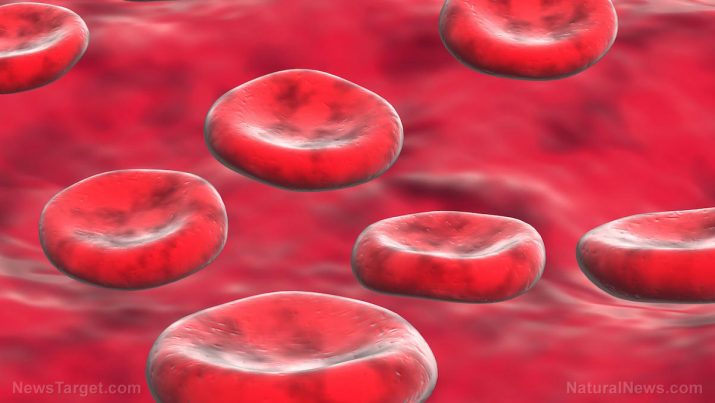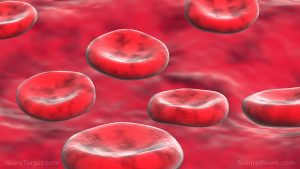
Essential thrombocythemia – causes, side effects and treatments at NaturalPedia.com
Friday, March 23, 2018 by Zoey Sky
http://www.naturalpedia.com/essential-thrombocythemia-causes-side-effects-and-treatments-at-naturalpedia-com.html

Essential thrombocythemia (ET) is also called essential thrombocytosis or primary thrombocythemia.
This condition is a myeloproliferative neoplasm that develops when the bone marrow doesn’t work properly and produces too many platelets. Since essential thrombocytosis is a chronic disorder, it develops slowly over time. ET increases the risk of blood clots and bleeding in patients.
Experts have yet to determine the exact cause of essential thrombocytosis, but some individuals with the condition have a mutation (change) in the Janus kinase 2 (JAK2) gene. The cause of this gene mutation is also unknown.
People who are at least 60 years old usually develop essential thrombocytosis. The condition may also develop in younger people, especially women of child-bearing age. Pregnant women with untreated ET are at risk of complications such as miscarriage, the slower development of the fetus, and premature birth.
In rare cases, ET develops into polycythemia vera (PV), myelofibrosis, a myelodysplastic syndrome, or acute myelogenous leukemia (AML).

Known side effects of essential thrombocythemia
While patients with essential thrombocythemia don’t usually experience any side effects, a blood clot may be the first sign that something is wrong.
Although blood clots may form anywhere in the body, they usually form in the feet, hands, or brain. The symptoms of a blood clot will vary depending on where the clot is located.
The symptoms of ET may include:
- Changes in vision
- Chest pain
- Fainting
- Headache
- Lightheadedness /dizziness
- Numbness/tingling in the feet or hands
- Redness, throbbing, and burning pain in the feet or hands
- A slightly enlarged spleen
- Weakness
In rare cases, essential thrombocythemia can cause bleeding which may occur in the form of:
- Bleeding from the gums or mouth
- Bloody stool
- Easy bruising
- Hematuria (bloody urine)
- Nosebleeds
Body systems harmed by essential thrombocythemia
Women who are diagnosed with essential thrombocythemia and also use birth control pills have a chance of developing blood clots. ET is also dangerous for pregnant women since a blood clot in the placenta can cause problems with fetal development or miscarriage.
A blood clot may also result in a transient ischemic attack (TIA) or a stroke. Symptoms of stroke include:
- Blurred vision
- Confusion
- Difficulty speaking
- Seizures
- Shortness of breath
- Weakness/numbness in the limbs or face
Individuals with ET are also at risk of a heart attack since blood clots can block the flow of blood to the heart. Symptoms of a heart attack include:
- Pain that extends to the shoulder, arm, back, or jaw
- Shortness of breath
- Skin that feels clammy to the touch
- Squeezing pain in the chest that lasts longer than a few minutes
Consult a healthcare professional or go to the hospital immediately if you experience the following symptoms which are considered medical emergencies and require immediate treatment:
- A blood clot
- Heart attack
- Heavy bleeding
- Stroke
Food items or nutrients that may prevent essential thrombocythemia
While essential thrombocythemia is often treated with medication, a proper diet, dietary supplementation, and avoiding several food groups may help prevent the condition and manage its symptoms.
Avoid the following foods to manage ET:
- Alcohol, caffeine, meat, and tobacco — These substances are bad for your cardiovascular health, which is a major health concern for patients with the condition. Replace red meat with sources of lean protein like beans, cold-water fish, poultry, and tofu. Caffeine and tobacco can raise blood pressure. Alcohol must be consumed very moderately since it can cause nutritional imbalances.
- Fats — Saturated fats are linked to cardiovascular diseases such as atherosclerosis, heart attack, and stroke. Replace saturated fats with vegetable oils such as olive and canola oils. Additionally, patients with ET mush avoid foods with trans-fatty acids, which are usually hidden in store-bought baked goods like cookies and crackers. Trans-fatty acids are also found in donuts, fried potatoes, margarine, and various processed foods.
- Refined foods — This includes grains that have been stripped of bran (endosperms) and sugar. Replace them with whole grains like brown rice, whole grain bread, and whole wheat pasta. Whole grains help lower cholesterol, which will benefit patients with ET, and improve intestinal health.
Treatments, management plans for essential thrombocythemia
Treatment plans for patients with essential thrombocythemia often depend on several factors like the risk of developing blood clots.
Individuals without any symptoms or additional risk factors may not require treatment. A healthcare professional may opt to monitor your condition instead.
However, treatment may be recommended if a patient:
- Has other medical conditions like diabetes or cardiovascular disease
- Has a history of bleeding or blood clots
- Is older that 60
- Is a smoker
Treatment for essential thrombocythemia may include:
- Over-the-counter low-dose aspirin (Bayer), which may reduce blood clotting.
- Prescription medications, which may reduce the risk of clotting or minimize platelet production in the bone marrow.
- Plateletpheresis, a procedure that extracts platelets directly from the blood.
Where to learn more
- Aspirin Sold as a Wonder Drug for All That Ails, But Falls Far Short
- Health.news
- Important Things to Consider Before Hip or Knee Replacement Surgery
- Medicine.news
- NaturalCures.news
Summary
Essential thrombocythemia (ET) is also called essential thrombocytosis or primary thrombocythemia.
This condition is a myeloproliferative neoplasm that develops when the bone marrow doesn’t work properly and it produces too many platelets. Since essential thrombocytosis is a chronic disorder, it develops slowly over time. ET increases the risk of blood clots and bleeding in patients.
While patients with essential thrombocythemia don’t often experience any side effects, a blood clot may be the first sign that something is wrong.
Although blood clots may form anywhere in the body, they usually form in the feet, hands, or brain. The symptoms of a blood clot will vary depending on where the clot is located.
The symptoms of ET may include changes in vision, chest pain, fainting, and headache.
Women who are diagnosed with essential thrombocythemia and also use birth control pills have a chance of developing blood clots. ET is also dangerous for pregnant women since a blood clot in the placenta can cause problems with fetal development or miscarriage.
A blood clot may also result in a transient ischemic attack (TIA) or a stroke.
While essential thrombocythemia is often treated with medication, a proper diet, dietary supplementation, and avoiding several food groups may help prevent the condition and manage its symptoms.
Avoid alcohol, caffeine, fats, meat, refined foods, and tobacco to manage ET. Consume more lean proteins, vegetable oils, and whole grains to help prevent the condition.
Treatment plans for patients with essential thrombocythemia often depend on several factors like the risk of developing blood clots.
Individuals without any symptoms or additional risk factors may not require treatment. A healthcare professional may monitor your condition. Treatment for essential thrombocythemia may include over-the-counter low-dose aspirin, prescription medications, and plateletpheresis.
Sources include:
Tagged Under: Tags: essential thrombocythemia





